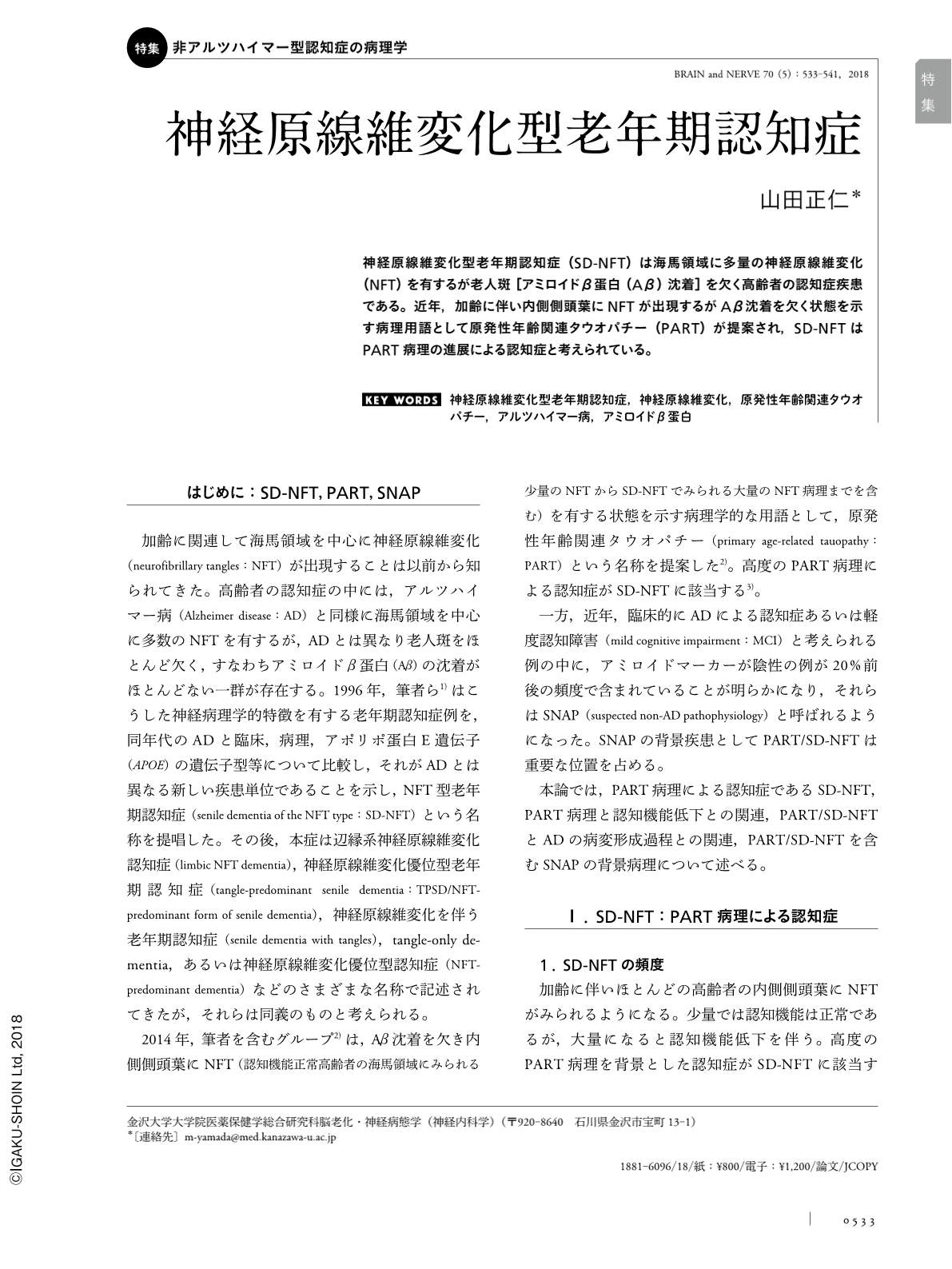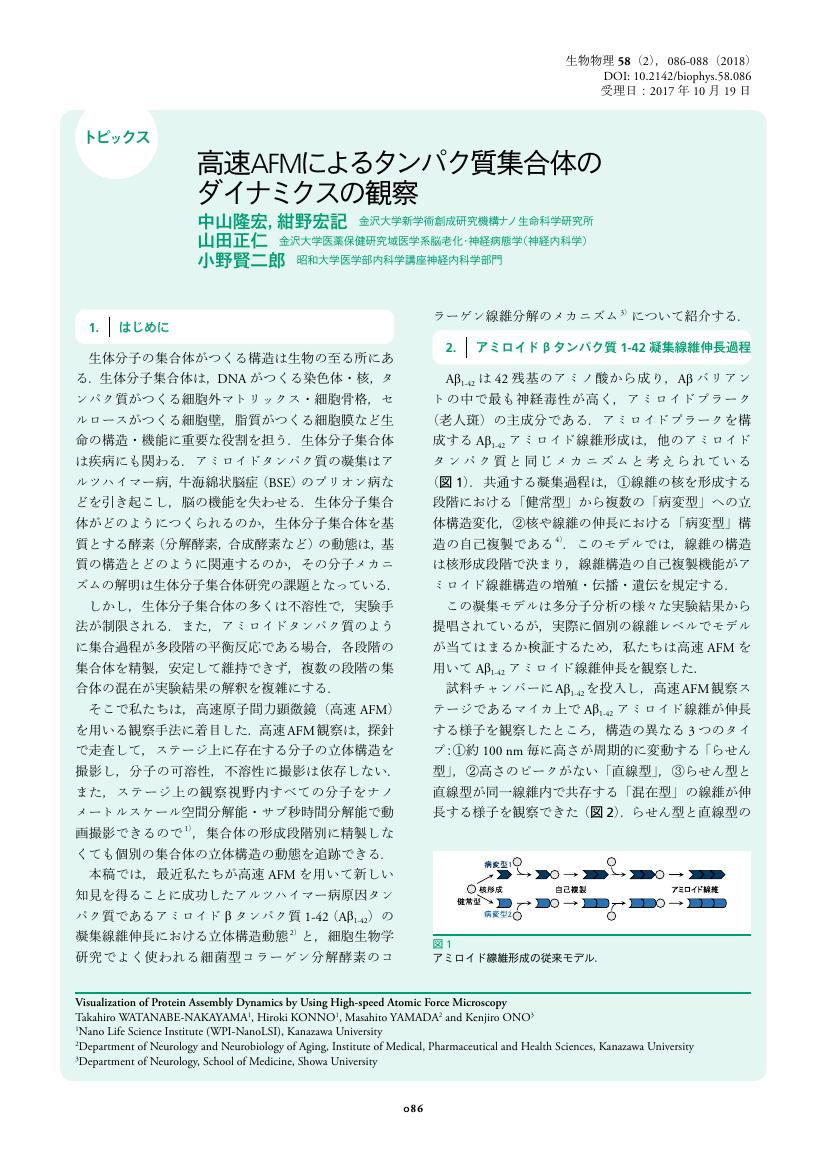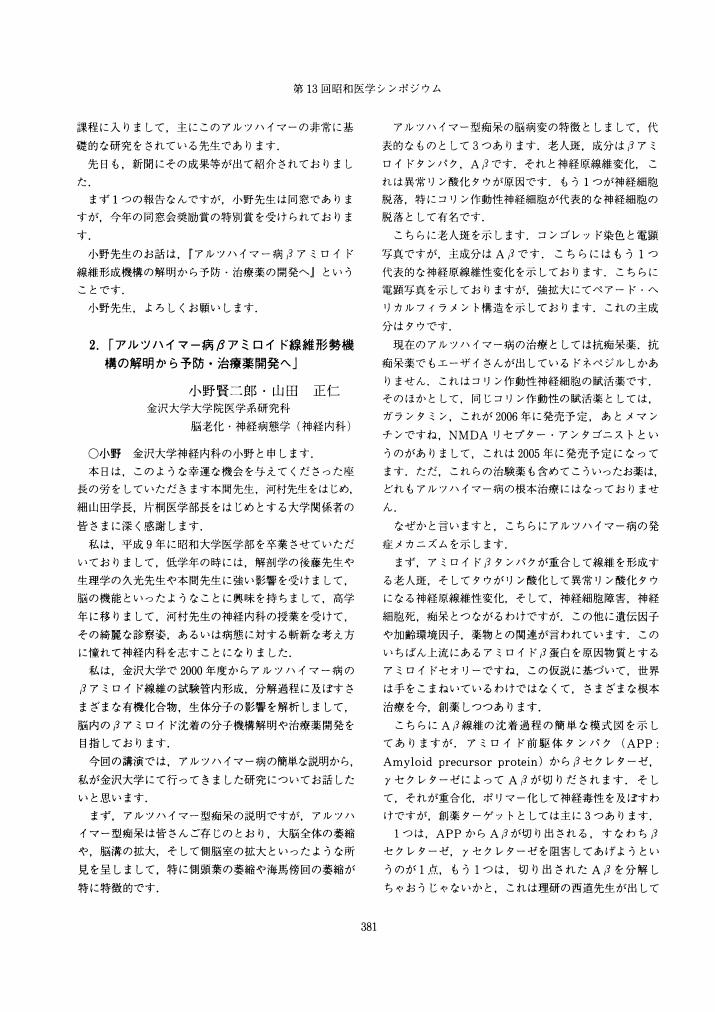1 0 0 0 OA 医療行為によるアミロイドβタンパク質病理の個体間伝播
- 著者
- 浜口 毅 山田 正仁
- 出版者
- 日本神経感染症学会
- 雑誌
- NEUROINFECTION (ISSN:13482718)
- 巻号頁・発行日
- vol.25, no.1, pp.65, 2020 (Released:2020-05-13)
- 参考文献数
- 33
【要旨】Creutzfeld-Jakob 病(Creutzfeldt-Jakob disease、以下 CJD)に代表されるプリオン病は、脳における海綿状変化と異常プリオンタンパク質蓄積を特徴とする神経変性疾患である。ウシ海綿状脳症からヒトへ伝播したと考えられる変異型 CJD やヒト乾燥屍体硬膜移植や成長ホルモン療法、脳外科手術等によって伝播したと考えられる医原性 CJD のように、プリオン病は同種間あるいは異種間で伝播しうる。一方、Alzheimer 病(Alzheimer's disease、以下 AD)の病理学的特徴の一つであるアミロイドβタンパク質(amyloid β protein、以下 Aβ)の脳への沈着も、プリオン病の異常プリオンタンパク質と同様に個体間を伝播することを示す動物実験結果が近年多数報告され、さらに、硬膜移植後 CJD や成長ホルモン製剤関連 CJD といった医原性CJD 剖検脳の検討から Aβ病理変化がヒトにおいても個体間を伝播した可能性が報告されている。脳血管へのアミロイド沈着症である脳アミロイドアンギオパチー(cerebral amyloid angiopathy、以下 CAA)は、脳血管へ Aβが沈着する孤発性 CAA(Aβ-CAA)が、高齢者や AD 患者でしばしば認められるが、若年での報告はきわめて少ない。しかし、近年、若年発症の CAA 関連脳出血の症例が複数報告され、それらの症例は脳外科手術歴を有していたことから、脳外科手術での Aβ-CAA が個体間伝播した可能性が指摘されている。 これらの症例にはヒト乾燥屍体硬膜移植がはっきりしない症例も含まれており、ヒト乾燥屍体硬膜移植だけでなく脳外科手術器具によって Aβ-CAA が個体間伝播した可能性も疑われている。
1 0 0 0 OA 神経原線維変化型老年期認知症
- 著者
- 山田 正仁
- 出版者
- 認知神経科学会
- 雑誌
- 認知神経科学 (ISSN:13444298)
- 巻号頁・発行日
- vol.17, no.1, pp.32-39, 2015 (Released:2016-12-06)
- 参考文献数
- 31
【要旨】筆者らは、Alzheimer病(AD)と同様に海馬領域を中心に多数の神経原線維変化(NFT)を有するが老人斑をほとんど欠く認知症の一群について、同年代のADと臨床、病理、アポリポ蛋白E遺伝子型等について比較し、それがADとは異なる新しい疾患単位であることを示し、NFT型老年期認知症(senile dementia of the NFT type:SD-NFT)という名称を提唱した(1996)。高齢者認知症における本症の頻度は約5%である。臨床的には、高齢者に孤発性に発症し、緩徐進行性の認知症を主徴とする。初期には、記憶障害が主体であり、他の認知機能や人格は比較的保たれる(軽度認知障害段階)。記憶障害が非常に緩徐に進行した後、失見当識や他の認知機能障害があらわれる(認知症段階)。頭部CTやMRIでは海馬領域の萎縮がみられる。血管性病変などが共存してみられることが多い。アミロイドイメージングはADとの鑑別に有用であり、アミロイド陰性例の中に本症は含まれる。タウイメージングの臨床研究が進行している。脳脊髄液マーカーについては、SD-NFTではリン酸化タウの異常はみられるがAβ1-42に異常はみられないことが想定されるが病理学的確実例における検証が必要である。本症に対する有効性が検証された治療法はない。疾患修飾療法としてタウ標的療法の開発が進行している。
1 0 0 0 認知症予防として地域で行った運動プログラムの効果
- 著者
- 横川 正美 山田 正仁 菅野 圭子 柚木 颯偲 堂本 千晶 吉田 光宏 浜口 毅 高橋 和也 岩佐 和夫 駒井 清暢
- 出版者
- 公益社団法人 日本理学療法士協会
- 雑誌
- 理学療法学Supplement
- 巻号頁・発行日
- vol.2008, pp.E3P3233, 2009
【目的】認知症予防のための方法は種々報告されており、運動に関しては有酸素運動が効果的であるとされているが一定の見解には至っていない.本研究では地域住民を対象に有酸素運動を主体とした運動機能プログラムを実施し、その効果について同時期に行われた認知機能プログラムと比較検討した.<BR><BR>【方法】前年度に地域で実施された脳健診の受診者から、脳老化関連疾患の疑われる者および介入法参加に支障をきたすような身体疾患のある者を除き、臨床的認知症尺度(Clinical Dementia Rating; CDR)が0または0.5にあたる健常者または軽度認知障害者379名に本研究への参加を募った.参加への同意の得られた36名のうち、介入前後の評価を実施できた29名を本研究の対象とした.介入法はプログラムを2つ設け、参加者を無作為に振り分けた.一つは認知機能プログラム(n=12)で、認知症の前段階で低下しやすいと考えられている実行機能を重点的に高める内容として、A.ゲームやパズル、B.地域の地図作り、C.自助具技術の習得を行った.もう一つは有酸素運動を主体とした運動機能プログラム(n=17)で、A.体調確認、B.テレビ体操(ウォーミングアップ)、C.ウォーキング、D.柔軟体操(クールダウン)を行った.2つのプログラムはどちらも週1回約1時間で合計14回、4ヶ月間にわたって実施した.認知機能プログラムはAからCをそれぞれ4回程度ずつ費やして行い、運動機能プログラムはAからDを毎回行った.対象者には介入前後に認知機能検査としてファイブ・コグを施行した.<BR><BR>【結果】参加者の平均年齢は72.2±7.1歳、平均教育年数は10.4±2.3年であった.2つのプログラムの間で対象者の年齢、教育歴による差はみられなかった.参加者の年齢層や日常的な活動の幅を考慮して、運動プログラムでのウォーキングは10分より開始し、6回目より15分に延長した.実施期間中に体調不良を訴えた者はなかった.介入前後の認知機能検査において、認知機能プログラムでは「手がかり再生課題」が12.6±5.6点から17.0±5.7点へ、「動物名想起課題(言語流暢性課題)」が12.8±4.0点から16.4±2.9点へとそれぞれ有意に改善した(いずれもp<0.01).運動機能プログラムでは「手がかり再生課題」のみ、11.5±5.3点から16.2±5.3点へと有意に改善した(p<0.01).<BR><BR>【考察】認知機能検査において、両プログラムで「手がかり再生課題」が改善し、記憶機能の改善が示唆された.アルツハイマー病では初期に記憶機能が低下するとされている.記憶機能の改善が示唆された今回のプログラムはどちらも予防プログラムとして効果的であることが考えられた.その一方で運動機能プログラムでは認知機能プログラムで示された言語流暢性課題の改善は得られなかった.今後は運動内容の再考や、さらに対象者が今回のプログラムで獲得した体力を維持し、長期的に認知症予防に取り組めるような支援方法の検討が必要と考える.
1 0 0 0 神経原線維変化型老年期認知症
- 著者
- 山田 正仁
- 出版者
- 医学書院
- 雑誌
- BRAIN and NERVE-神経研究の進歩 (ISSN:18816096)
- 巻号頁・発行日
- vol.70, no.5, pp.533-541, 2018-05-01
神経原線維変化型老年期認知症(SD-NFT)は海馬領域に多量の神経原線維変化(NFT)を有するが老人斑[アミロイドβ蛋白(Aβ)沈着]を欠く高齢者の認知症疾患である。近年,加齢に伴い内側側頭葉にNFTが出現するがAβ沈着を欠く状態を示す病理用語として原発性年齢関連タウオパチー(PART)が提案され,SD-NFTはPART病理の進展による認知症と考えられている。
1 0 0 0 OA 認知症:Update
- 著者
- 山田 正仁
- 出版者
- 日本神経治療学会
- 雑誌
- 神経治療学 (ISSN:09168443)
- 巻号頁・発行日
- vol.35, no.3, pp.157-161, 2018 (Released:2018-12-25)
- 参考文献数
- 20
Suspected non–Alzheimer's disease (AD) pathophysiology (SNAP) is a biomarker–based concept that is defined as a condition characterized by normal levels of amyloid–β protein (Aβ) markers (A−), but abnormal neurodegeneration (or neuronal injury) markers (N+). Recent studies indicated that SNAP is found in 17–35% of individuals with mild cognitive impairment (MCI). Similarly, 7–39% of patients with clinically probable AD dementia are negative for Aβ. Progression of cognitive impairment in individuals with SNAP is slower than that in A+N+ subjects with high likelihood of AD pathophysiology. Pathological backgrounds of SNAP are heterogeneous, including non–AD neurodegeneration, cerebrovascular disorders, and mixed pathologies. Non–AD neurodegeneration would include primary age–related tauopathy (PART), which corresponds to senile dementia of the neurofibrillary tangle type (SD–NFT) (tangle–only dementia) at the stage of dementia, and argyrophilic grain disease. Pathogenesis of AD in older people would be more complex than previously recognized, in which widespread Aβ and tau pathologies may be commonly preceded by PART pathology in the medial temporal lobe. Further, current trials of disease–modifying therapies for AD are reviewed. In addition, the author refers to a preventive intervention against dementia/AD with polyphenols under development by his group.
1 0 0 0 OA アルツハイマー病の早期診断
- 著者
- 吉田 光宏 山田 正仁
- 出版者
- 一般社団法人 日本臨床化学会
- 雑誌
- 臨床化学 (ISSN:03705633)
- 巻号頁・発行日
- vol.35, no.4, pp.359-365, 2006-11-10 (Released:2012-11-27)
- 参考文献数
- 40
1 0 0 0 OA 高速AFMによるタンパク質集合体のダイナミクスの観察
- 著者
- 中山 隆宏 紺野 宏記 山田 正仁 小野 賢二郎
- 出版者
- 一般社団法人 日本生物物理学会
- 雑誌
- 生物物理 (ISSN:05824052)
- 巻号頁・発行日
- vol.58, no.2, pp.086-088, 2018 (Released:2018-03-31)
- 参考文献数
- 9
1 0 0 0 地域住民を対象とした認知症予防プログラムの効果
- 著者
- 横川 正美 菅野 圭子 柚木 颯偲 堂本 千晶 吉田 光宏 浜口 毅 柳瀬 大亮 岩佐 和夫 駒井 清暢 山田 正仁
- 出版者
- JAPANESE PHYSICAL THERAPY ASSOCIATION
- 雑誌
- 日本理学療法学術大会
- 巻号頁・発行日
- vol.2009, pp.E3O2227-E3O2227, 2010
【目的】昨年の日本理学療法学術大会において、地域住民を対象に認知症予防として実施した認知機能プログラムと運動機能プログラムの効果を調べたところ、前者のみならず、後者のプログラムでも記憶機能の改善が示唆されたことを報告した。本研究では、同様のプログラムを再度実施し、プログラムに参加していない対照群との比較を行った。<BR>【方法】一昨年度および前年度に地域で実施された脳健診の受診者から、明らかな脳疾患を有する者、および臨床的認知症尺度(Clinical Dementia Rating; CDR)が1以上のものを除いた806名に研究参加を募った。参加への同意が得られた37名のうち、介入前後の評価を実施できた31名を介入法の対象者とした。対照群として、本研究の趣旨を説明し協力の同意が得られたグループデイ参加者20名のうち、介入群と同時期に評価を実施できた13名を対象者とした。グループデイは概ね65歳以上で、週1回以上自主的に運営し活動するグループであり、本研究の介入法には参加していない。介入法では、参加者を無作為に2つのプログラムのうち、次のいずれかに振り分けた。一つは認知プログラム(n=17)で認知症の前段階で低下しやすいと考えられている実行機能を重点的に高める内容であり、具体的には旅行の計画立案と実施を行った。もう一つは運動プログラム(n=14)で認知機能に効果的とされる有酸素運動を主体としており、体調確認の後、準備運動、ウォーキング(10-15分)、柔軟体操を行った。2つのプログラムはどちらも週1回約1時間、合計8回実施した。介入法参加者と対照群には介入前後に認知機能検査としてファイブ・コグを施行した。<BR>【説明と同意】参加者に本研究の趣旨を説明し、書面にて同意を得た。本研究は所属する機関の医学倫理委員会の承認を得た。<BR>【結果】参加者の平均年齢は72.8±4.3歳、平均教育年数は10.0±2.0年であった。認知プログラム、運動プログラム、対照群の間で対象者の年齢、教育歴による差はみられなかった。ファイブ・コグの下位項目(運動、注意、記憶、視空間認知、言語流暢性、思考)の各評価得点について、2つのプログラムと対照群のうち、どれに参加したかという「プログラム」因子と、参加前か参加後かという「時間」因子による二元配置分散分析を行ったところ、交互作用が認められた項目はなかった。次に参加前、参加後の各評価得点をプログラム間で多重比較したところ、有意差が認められた項目はなかった。各プログラム内での多重比較では、認知プログラムにおいて、運動(22.4±5.6点→24.8±6.3点; p<0.05)と記憶(13.4±6.5点→17.1±6.1点; p<0.01)の得点が参加後、有意に改善した。運動プログラムにおいても同じく運動(19.4±6.5点→22.7±6.4点; p<0.01)と記憶(12.4±7.3点→15.6±5.7点; p<0.05)の得点が参加後、有意に改善した。対照群では、参加前後で有意に変化した項目はなかった。<BR>【考察】対照群では認知機能検査において有意な改善が認められた項目がなかったのに対し、認知プログラムと運動プログラムでは記憶の項目が改善した。2つのプログラムは昨年も同様の結果が得られている。プログラム間で改善した認知機能に差異がみられる傾向にあるが、どちらのプログラムも有効性が示唆されたことから予防事業で用いる場合に効果が期待できると考えられた。<BR>【理学療法学研究としての意義】運動療法を用いた認知症予防の方法を提案するためのエビデンスを蓄積する。
1 0 0 0 OA 2.「アルツハイマー病βアミロイド線維形勢機構の解明から予防・治療薬開発へ」
- 著者
- 小野 賢二郎 山田 正仁
- 出版者
- 昭和大学学士会
- 雑誌
- 昭和医学会雑誌 (ISSN:00374342)
- 巻号頁・発行日
- vol.64, no.4, pp.381-385, 2004-08-28 (Released:2010-09-09)
1 0 0 0 OA 6.ヒトプリオン病の最近の動向
- 著者
- 山田 正仁
- 出版者
- 一般社団法人 日本内科学会
- 雑誌
- 日本内科学会雑誌 (ISSN:00215384)
- 巻号頁・発行日
- vol.97, no.3, pp.575-579, 2008 (Released:2012-08-02)
- 参考文献数
- 5




